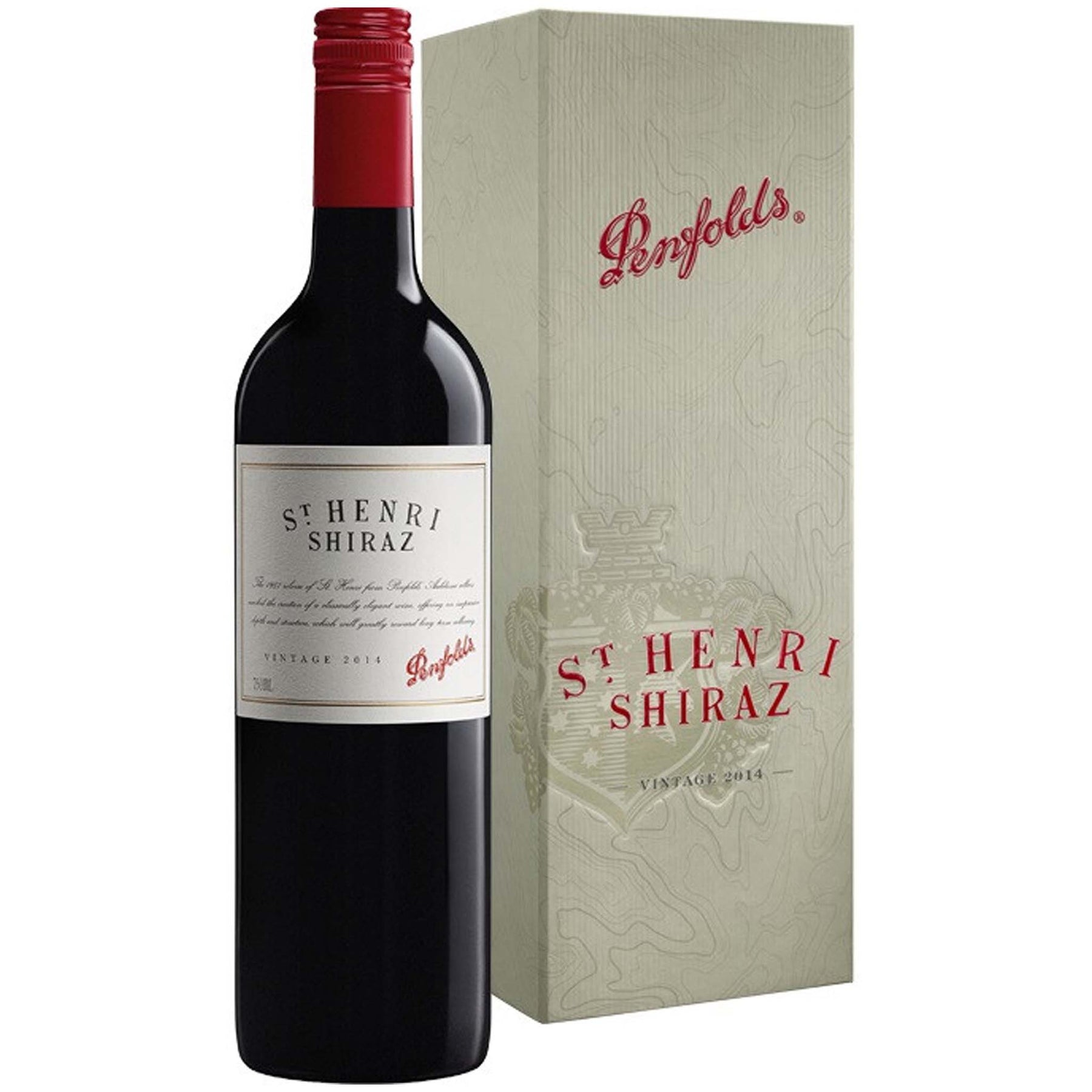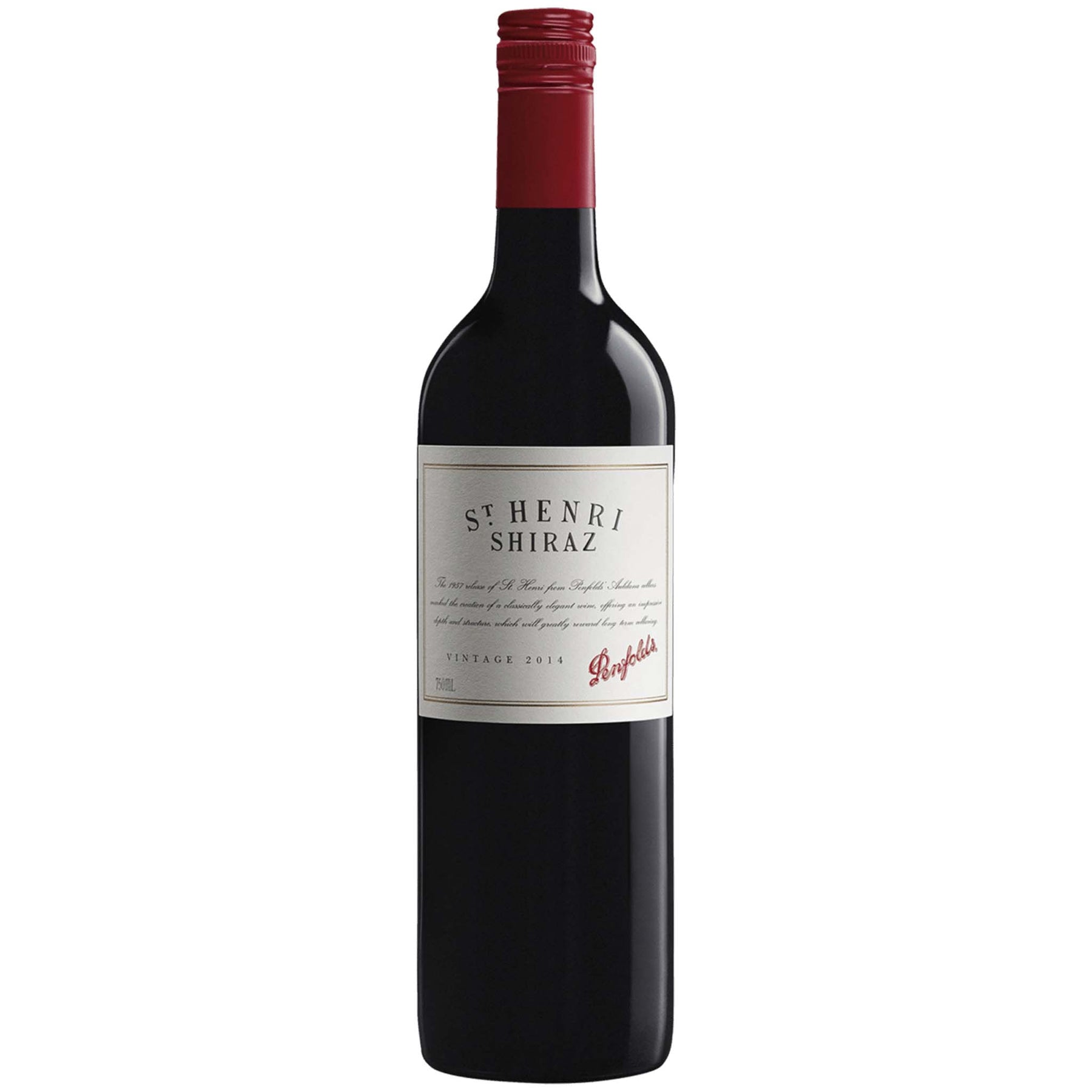


Penfolds St Henri Shiraz 2014 (Gift Box)
Style: Red Wine
Varieties: Shiraz (96%), Cabernet Sauvignon (4%)
Closure: Screwcap
Penfolds St Henri Shiraz 2014 (Gift Box)
Warehouse
34 Redland Drive
Vermont VIC 3133
Australia
Critic Score: 97
Alcohol: 14.5%
Size: 750 ml
Drink by: 2045
Penfolds Rewards of Patience tasting panel 2021 - 5/5 rating
St Henri is a time-honoured and alternative expression of Shiraz, and an intriguing counterpoint to Grange. It is unusual among high quality Australian red wines as it does not rely on any new oak. Released for the first time by Penfolds in the early 1950s (first commercial vintage 1957), it gained a new lease of life in the 1990s as its quality and distinctive style became better understood. Proudly, a wine style that hasn't succumbed to the dictates of fashion or commerce. St Henri is rich and plush when young, gaining soft, earthy, mocha-like characters as it ages. It is matured in old, 1,460 litre vats that allow the wine to develop, imparting minimal, if any oak character. Although a small proportion of Cabernet is sometimes used to improve structure, the focal point for St Henri remains Shiraz.
"The wine is medium to full-bodied and remarkably softly-textured, with density and fleshy extract, and a very savoury countenance. Long, long carry. Lovely wine, the opposite of what might be termed a fruit-bomb." Huon Hooke
"The abiding character of St Henri is its longevity, particularly in the context of better vintages. It has none of the make-up of new American oak that can hide the imperfections of a lesser vintage. A great St Henri will come into its own in a bare minimum of 10 years, and live long thereafter." James Halliday
The 2014 Penfolds St Henri is a blend of 96% shiraz and 4% cabernet sauvignon from premium vineyards in the Barossa Valley, Adelaide Hills, Southern Fleurieu, Wrattonbully and McLaren Vale. It was aged for 12 months in 50+ y.o. large oak vats.
"Deep crimson. Fresh elderberry, blackberry, camomile, praline, aniseed and herb garden aromas. Concentrated, exuberant and elemental with elderberry, blackberry and dark chocolate liqueur flavours, attractive negroni notes and classic fine grainy tannins. Finishes chalky firm with an aniseed kick. A superb vintage. Peak drinking 2023 to 2040.
Vintage Conditions: Above-average winter and early spring rainfall offered the vines in South Australia healthy soil moisture profiles for the growing season. Late spring and summer were dry and warm with significant heat records being set. Warm weather prevailed during summer and throughout veraison, allowing grapes to develop evenly and with good intensity. The warm conditions came to an abrupt halt in mid-February with significant rainfall that allowed for a long and slow ripening of the fruit in very good conditions. This ensured balanced flavour development, fruit exhibiting a brightness endowed with crisp acid retention and impressive fruit quality." Penfolds
Expert reviews
"Deep crimson. Fresh elderberry, blackberry, camomile, praline, aniseed and herb garden aromas. Concentrated, exuberant and elemental with elderberry, blackberry and dark chocolate liqueur flavours, attractive negroni notes and classic fine grainy tannins. Finishes chalky firm with an aniseed kick. A superb vintage. Peak drinking 2023 to 2040." Penfolds Rewards of Patience tasting panel 2021 - 5/5 rating
"A polished and effortless blueberry, satsuma plum and black olive integrity define a St Henri of enduring, fine-grained tannin structure, undeviating line and grand persistence. Nuances of pepper offer dimension and intrigue. There is an evenness and an effortless focus that set this vintage apart among the great St Henris, approachable from the outset and yet possessing surprising endurance. Drink 2019-2034." Tyson Stelzer, Wine Taste - 97 points
"Matured for 12 month in 50+yo large oak vats. No barrel fermentation, no oak flavours of any description, but none needed. This is all about fruit purity, shiraz with the faintest damask of blackcurrant wrapped around it. More than any other of the top range of the Penfolds red wine hierarchy, will repay patience. Drink by: 2044." James Halliday, Halliday Wine Companion - 95 points
"The stewed plums, the fresh boysenberry, the hint of leather, the general downplay of oak. It sits there, comfortable in its own skin, pretty much immune to the traffic of time. Move past the aromas with this release though and we see a fair bit if grunt; some meaty characters, a deep set of plums, almost a ferrous character, certainly peppercorns, florals. There's a ramp of tannin here slightly outside the St Henri norm; it gives the wine a wee bit of strut. Just a wee bit. But we are certainly in excellent territory here. Drink: 2021-2031+." Campbell Mattinson, The Wine Front - 95 points
"Deep, dense red colour with a good tinge of purple; the bouquet very sweet plum, with a sooty, earthy overlay. The wine is medium to full-bodied and remarkably softly-textured, with density and fleshy extract, and a very savoury countenance. Cocoa powder, tar, licorice and spice, especially on the finish and aftertaste. Long, long carry. Lovely wine, the opposite of what might be termed a fruit-bomb. Drink: 2017-2047." Huon Hooke, The Real Review - 95 points
Awards
Penfolds Rewards of Patience tasting panel 2021 - 5/5 rating
About st henri

The first vintage of St Henri – then Auldana Cellars St Henri Claret – was produced in 1888, beginning one of the most famous and enduring names in Australian wine. It was likely named after Auldana's winemaker Léon Edmond Mazure's son Henri or his wife, Philomine Henriette. The wine immediately enjoyed success, winning the Championship Cup for Best Claret in Australia at the Adelaide Wine Show in 1890 and then again as a joint winner in 1891. The St Henri label disappeared somewhere around the beginning of World War 1, probably because of reduced export sales. It was revived by Senior Red Winemaker John Davoren at Penfolds in 1953 to celebrate the centenary of Auldana Cellars (established by Patrick Auld in 1853) but the wine was not widely released. The 1953 release was made from Auldana and Paracombe fruit and the label design was based on original St Henri labels found in a loft at Auldana Cellars shortly after its sale to Penfolds in 1947.
According to retired Penfolds Senior Winemaker John Bird, the first vintages of St Henri were cabernet sauvignon and mataro blends. The fruit was foot stomped in open-ended hogsheads during vinification. After fermentation, the wine was matured in oak vats rather than hogsheads for around 18 months. John Davoren's aim was to make a wine in the traditional Claret style, accentuating fruit and maturation characters, rather than oak complexity. In this way the winemaking style differs to Grange, as it relies on larger seasoned oak vessels without any barrel fermentation. The 1957 vintage is officially recognised as the first St Henri commercial release under the Penfolds name. Nonetheless, John Davoren describes all of the 1950s vintages as "trials”. These experimental wines from 1953 to 1959 mark an important step forward for winemaking in Australia. Not only does St Henri honour the late 19th-century aspirations of Auldana's proprietor Sir Josiah Symon and winemaker Léon Edmond Mazure, but without the professional rivalry between Max Schubert and John Davoren, the Grange story would not have the same richness or romance. Initially St Henri achieved greater commercial success than Grange, although both were offered to the public as Claret styles. St Henri was a more elegant, approachable and familiar style because it reflected traditional winemaking techniques, whereas the revolutionary Grange was something of a blockbuster with more richness and fullness.
Today Penfolds St Henri is a multi-regional multi-vineyard South Australian blend, primarily based on shiraz, although it still honours the original style. Significant contrbutions of shiraz come from Barossa Valley, Eden Valley, Clare Valley, McLaren Vale, Langhorne Creek, Robe and Bordertown; cabernet sauvignon from Coonawarra, Barossa Valley and Adelaide Hills. After vinification the wine is matured in seasoned large oak vats for around 15 to 18 months before bottling.
St Henri was labelled 'Claret' until the 1989 vintage. Packaged in laser-etched bottles
since the 1996 vintage. Released in many markets under screwcap since 2005. St Henri Shiraz possesses a unique stature in the story of Australian wine. With its proven style and aging potential, it is a favourite among Penfold's collectors.
Extract from Penfolds Rewards of Patience tasting panel 2021
After the success of early sherries and fortified wines, founders Dr Christopher and Mary Penfold planted the vine cuttings they had carried on their voyage over to Australia. In 1844 the fledging vineyard was officially established as the Penfolds wine company at Magill Estate.
As the company grew, so too did Dr Penfold's medical reputation, leaving much of the running of the winery to Mary Penfold. Early forays into Clarets and Rieslings proved increasingly popular, and on Christopher's death in 1870, Mary assumed total responsibility for the winery. Mary's reign at the helm of Penfolds saw years of determination and endeavour.
By the time Mary Penfold retired in 1884 (ceding management to her daughter, Georgina) Penfolds was producing 1/3 of all South Australia's wine. She'd set an agenda that continues today, experimenting with new methods in wine production. By Mary's death in 1896, the Penfolds legacy was well on its way to fruition. By 1907, Penfolds had become South Australia's largest winery.
In 1948, history was made again as Max Schubert became the company's first Chief Winemaker. A loyal company man and true innovator, Schubert would propel Penfolds onto the global stage with his experimentation of long-lasting wines - the creation of Penfolds Grange in the 1950s.
In 1959 (while Schubert was perfecting his Grange experiment in secret), the tradition of ‘bin wines' began. The first, a Shiraz wine with the grapes of the company's own Barossa Valley vineyards was simply named after the storage area of the cellars where it is aged. And so Kalimna Bin 28 becomes the first official Penfolds Bin number wine.
In 1960, the Penfolds board instructed Max Schubert to officially re-start production on Grange. His determination and the quality of the aged wine had won them over.
Soon, the medals began flowing and Grange quickly became one of the most revered wines around the world. In 1988 Schubert was named Decanter Magazine's Man of the Year, and on the 50th anniversary of its birth, Penfolds Grange was given a heritage listing in South Australia.
Despite great success, Penfolds never rests on its laurels. In 2012 Penfolds released its most innovative project to date - 12 handcrafted ampoules of the rare 2004 Kalimna Block Cabernet Sauvignon.
Two years later, Penfolds celebrated the 170th anniversary – having just picked up a perfect score of 100 for the 2008 Grange in two of the world's most influential wine magazines. Today, Penfolds continues to hold dear the philosophies and legends – ‘1844 to evermore!'.

South Australia
South Australian is responsible for more than half the production of all Australian wine. It is home to more than 900 wineries across 18 wine regions. The regions are Adelaide Hills, Adelaide Plains, Barossa Valley, Clare Valley, Coonawarra, Currency Creek, Eden Valley, Kangaroo Island, Langhorne Creek, McLaren Vale, Mount Benson, Mount Gambier, Padthaway, Riverland, Robe, Southern Fleurieu, Southern Flinders Ranges and Wrattonbully.
Many of the well-known names in the South Australian wine industry established their first vineyards in the late 1830s and early 1840s. The first vines in McLaren Vale were planted at Reynella in 1839 and Penfold's established Magill Estate on the outskirts of Adelaide in 1844.
South Australia has a vast diversity in geography and climate which allows the State to be able to produce a range of grape varieties - from cool climate Riesling in the Clare and Eden Vallies to the big, full bodied Shiraz wines of the Barossa Valley and McLaren Vale. Two of Australia's best-known wines, Penfolds Grange and Henschke Hill of Grace, are produced here. There is much to discover in South Australia for the wine lover.



